October 28, 2022 – Volume 24, Issue 10
In This Issue
- Flanigan’s Eco-Logic: Visiting Alaska
- Alaskan Geography
- Juneau and Whale-Watching
- Icy Straits and Salmon
- Glacier Bay and Glaciers
- Ketchikan and Lumber
- Alaska and Oil
- Reflections
- The NetPositive Podcast Updates

Flanigan’s Eco-Logic: Visiting Alaska
Terry and I had been planning this cruise to Alaska for some time. As it is for many of us, we were startled when it was finally time to go! Already? Ah… the packing blues; then Uber to Bob Hope Airport. We leave Burbank in the rain and are welcomed with sunny skies at Sea-Tac, the regional airport shared by Seattle and Tacoma. That weather combination is rare, it’s usually the other way around but we’ll take it. A nice welcome to our trip north, a good omen? I’d be putting away my sunglasses soon.
Air Alaska Burbank to Sea-Tac, two hours and twenty minutes. Nice. Sea-Tac is among the greenest of airports, and we give it high marks for intermodal transport. Simple. We walk from baggage claim and take the light rail, the Sound Transit Link. It costs us $2 each to go all the way from the airport to downtown Seattle. There are Astros fans on the train; we drop them off at the stadium. It’s a calm, quiet, and efficient ride passing through neighborhoods. We emerge just a few blocks from our hotel.
That afternoon we hit Pike Place Market. It’s alive with flowers, jammed with people, the fish markets are oh so fresh. There, Dungeness crabs are stacked artistically. We take chowder overlooking the harbor. Later, I trek many blocks in record heat to witness the Bullitt Center first-hand. It’s a remarkable demonstration building, with a defining mortar-board solar array.
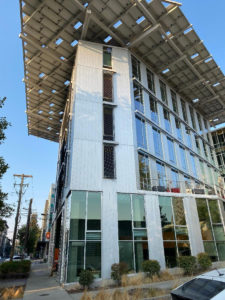
Fact of the Week
The State is huge, and hugely rich in resources. What a remarkable deal: The United States purchased Alaska from Russia in 1857 for $7.2 million dollars.
Alaskan Geography
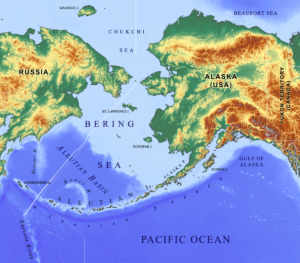
There’s nothing average about Alaska… known as the last frontier. It is the largest state by far, made up of 665,400 square miles. That’s huge. If overlaid on the continental U.S., it would stretch coast to coast. And it’s as big as Texas, California, and Montana combined. It’s equivalent to 488 Rhode Islands.
Alaska is sparsely populated. Its population amounts to only 736,990. It is the home of 224 tribes and 20 indigenous people. And for every 21 people, Alaska is home to one bear.
Alaska holds many geographic distinctions. It is only 50 miles from Russia. It borders the Canadian province of British Columbia and the Yukon Territory. It is the furthest north state, the furthest west and when considering that some of the Aleutian Islands cross the international date line, it’s also America’s easternmost state.
Alaska has lots of water! It has ~3,000 rivers and ~three million lakes. One of them, Lake Iliamna, is larger than the State of Connecticut. Glaciers are discussed in some depth later.
Alaska has more active volcanoes than any other state, 40 of them. It’s also home to 17 of the tallest mountains in America. It has whopping 33,904 miles of tidal shoreline. It has a bald eagle population of over 30,000.
The State is huge, and hugely rich in resources. What a remarkable deal: The United States purchased Alaska from Russia in 1857 for $7.2 million dollars. That’s two cents an acre. Alaska achieved U.S. statehood on January 3, 1959.

At noon we board the Norwegian Cruise Line Encore, a massive ocean liner. This is my second cruise, the first being the Queen Mary 2 back from England. Our stateroom is nicely appointed with a bottle of champagne. From our balcony I watch the fuel barge filling the ship’s fuel tanks. Our week-long adventure features Southeastern Alaska, sometimes called the Panhandle of Alaska. Our captain and ship will take us to Juneau, Icy Straits, Glacier Bay, and Ketchikan, stopping in Victoria, BC on the way back.
I hear the fans roar from Lumen Field just south of our pier as the Seahawks score against the Cardinals, and then a few minutes later there’s another more gentle roar… the extra point achieved I presume. It’s a gorgeous, sunny day and the City is alive. Ferries work their way to Bainbridge Island and beyond. Lots of boats. There’s a great mood on board… a time to relax, to get away, to meet new people, and to learn about distant places. Good mind food all.
At five o’clock and after a safety check at our assigned drill station, we feel the ship’s massive bow thrusters and engines push us from the dock. We’re off and at sea for the next day and half, up the coast of Vancouver Island and then British Columbia, and later into the inland passage, until we reach Juneau. The Norwegian ship is impressive in so many ways, its size, efficiency, comfort, and crew. For this trip, it’s 60% full. Those on board are eager to check out Alaska before winter sets in. We’re cutting it close.
Juneau and Whale-Watching

Alaska’s key industries are petroleum, tourism, fishing, timber, and mining. It is one of five states with no sales tax. Oil revenues are dominant. Juneau is the State’s capital. It’s the only capital city that is inaccessible by road. You must either fly in or come by boat. Railroads don’t make it here either. We dock downtown. The famous Mendenhall Glacier is just outside town. I’d been there in 1988 when I came to Juneau to speak at the Alaska Craftsman conference in the cold of winter.
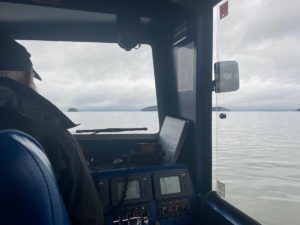
Whales hold such a mystique. We bus to Auke Bay Harbor, where we board a small whale-watching boat. Captain Tom and naturalist Brandon take good care of us for a few hours. I am struck by the excitement that whale-watching creates. “Whale at 9:00… 10:00!” This was no bust: We spent a precious few hours with about a dozen humpbacks, watching them weave up and down before submerging and exposing their signature tails. These are the real locals, and they come back year after year. Brandon can point out specific whales, they’ve all got nick-names! They feed here all summer before heading to Hawaii in winter to mate. Reportedly, they navigate the 2,800-mile journey within 1 compass degree. Remarkable.
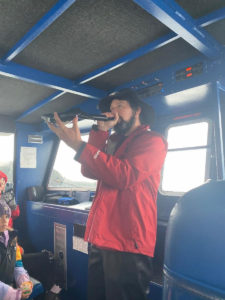
When feeding, the humpbacks take big gulps of seawater laden with fish and plankton and then push out the water through their sieve-like baleen structures. Technically, they “use keratinaceous baleen plates, or whalebone, to sieve planktonic creatures.” They feed up in Alaska, and then head off to Hawaii for the winter. There, the male whales show off to the females by breaching and making a big show. Other whales, such as Orcas, have teeth and use them liberally. They are the tough guys of the sea. Several passengers saw a pod of Orcas in Glacier Bay.
Humpbacks can get as big at 50,000 pounds. Females are larger than males. Baby whales, known as “calfs,” weigh a ton when born and within a year are on their own. Whales can live as long as 90 years. They blow plumes of steam as they clear their blowholes for more air before submerging for four minutes or so. We learn a bit about their personalities: These gentle giants are sometimes even mischievous and with a sense of humor, notes Brandon. They certainly create excitement on board as we dash from one vantage point to another, many cameras trained indeed. All ages find something wondrous about whales.
Icy Straits and Salmon

The Alaskan Rainforest is large and largely undeveloped. In Southeast Alaska there are hundreds of islands, 15,000 miles of coastline, over 19 million land acres and over 5 million acres of pristine old-growth rainforest. We learn that the largest temperate rainforest in the world is the Tongass National Forest in Alaska… about 26,250 square miles. We grow accustomed to heavily forested shorelines and steep hillsides marked with streams and waterfalls.
To our fellow passengers’ chagrin, nearly all shore excursions that day, from whale watching to kayaking and zip-lining are canceled due to weather, a cold and driving rain. It’s really unappealing outside. I love kayaking… but in this cold water and these conditions, the thought alone makes me shudder. Terry and I do don our raincoats to brave the elements ashore. Off the dock, and with wet shoes and pants, we take a gondola to Hoonah, site of a former canning factory. Leaving the shelter of the gondola, with winds picking up and rain in the face, we turn a corner along the shoreline and are hit with even more driving rain in the face. Nasty. White caps on the strait. In short order, we visit a salmon cannery, now a museum.
The factory is interesting, even gory with artistic depictions of the process of taking a salmon and ultimately putting it in a vacuum-sealed can. We learn about the five types of salmon, all from the family Salmonidae and how their names can be related to the fingers on our hands. We start with the thumb. Chum rhymes with Thumb. The pointer finger often socks us in the eye. Right? That’s Sockeye. The middle finger stands tall, like a King, King Salmon. The ring finger carries silver rings… Coho! The pinky… Pink Salmon. Now what about canned salmon? The docent explains that it’s just like canned tuna. Made me think: Wow, canned tuna took off; salmon is certainly not a common lunch meat.
We walk back from the cannery and take in the surroundings. Gray, ominous skies underscore this wild country. It’s hard to imagine settling here years ago, these imposing mountains and waterways, the dark of a long, cold winter. All these thoughts from the warmth and luxury on board our ship! Talkative we are and we make lots of friends, hot tub in the cold rain, and eat and drink an ungodly amount.
Glacier Bay and Glaciers
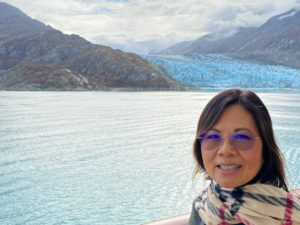
Alaska has ~100,000 glaciers. Fully 5% of its land area is covered in glacial snow and ice. The glaciers range from tiny, cirque glaciers to huge valley glaciers. And as with many other parts of the world, Alaska’s glaciers are experiencing alarming levels of decline. Fully 95% of its glaciers are thinning, stagnating, or retreating. Worldwide, glacial melt will cause sea levels to rise. In Alaska, its lake-terminating glaciers are retreating fastest. Bear Glacier retreated three miles from 1984 to 2021.
Just 250 years ago, Glacier Bay was all glacier and no bay. Its ice jutted out into Icy Straits. It was a massive river of ice 100 miles long. Today it has retreated, leaving a dozen smaller tidewater glaciers… the Reid Glacier, Lamplugh Glacier, Rendu Glacier, and Grand Pacific Glacier. When Captain George Vancouver sailed here in 1795, the glacier had melted back five miles into Glacier Bay. When John Muir visited Glacier Bay in 1879, the glacier had retreated 40 more miles up the bay. Today you must travel 65 miles up the bay to view the tidewater glaciers. We do that.
Through Icy Strait, into Sitakaday Strait, then Glacier Bay, and ultimately the Johns Hopkins Inlet… we are now in Glacier Bay National Park… the mighty ship gliding quietly in spectacular surroundings. We go to the bow of the ship. Glacier Bay’s waters are a rich green color. It’s where several glaciers make their way to sea. These are tidewater glaciers… gradually flowing to the ocean where they meet salt water and calve.
At Glacier Bay we dead end at the Johns Hopkins Glacier. What a view. There, the ship’s “azipods” are used to spin the ship slowly on its axis again and again to give all on board countless photo opps. Instead of conventional, and straight, propeller shafts, the ship uses azipods that are like jet engines that hang below the ship and that can spin 360 degrees to steer the ship.
As a result, these huge ships – that draw only 27 feet – can now maneuver in tight conditions that used to require tugboats. The ships can even go in reverse. Bow thrusters are used to move the bow into or away from the docks. Our ship also has massive stabilizers that are computer controlled to minimize rocking back and forth when in rough seas. Underwater, they are like wings on an airplane and have a 15-foot span that is hydraulically controlled.
Glacier Bay National Park is made up of three million protected acres just west of Skagway. It’s part of the 25-million acre world heritage site. It’s one of the world’s largest protected natural areas. It’s wild country: Brown and black bears, as well as grizzlies and moose, roam the park.
Ketchikan and Lumber
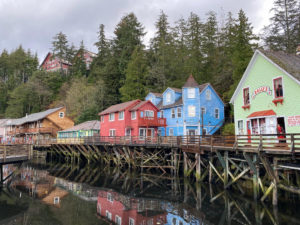
Trees they have in Alaska. Fully 35% of the entire State is forested. That percentage leaps to 48% in Southeast Alaska. Forests here are made up of Western Hemlock, Sitka Spruce, Mountain Hemlock, and Alaska Yellow Cedar. Alaska’s interior forests are made up of White Spruce, Birch, and poplars.
Trees abound. Why? Ketchikan gets 149 inches of rainfall annually! (Los Angeles’s average is 11.7 inches.) We dock at Ward’s Cove and at the site of a defunct pulp and paper mill. The mill had run around the clock since 1954 to 1997 converting timber, wood chips, and other wood products into wood pulp. The pulp was then used to produce paper, cardboard, and other products. Production has gradually shifted overseas. The Alaska Pulp Company shut down its Sitka plant four years earlier in 1993.
Back in 1951, the U.S. Forest Service entered into a 50-year contract with the Ketchikan Pulp Company to support local jobs by harvesting Alaskan timber resources and turning them into pulp. With that contract soon to expire, in 1996 Louisiana Pacific announced the plant’s closure. That was March 1997. It was the last pulp mill in Alaska to close. Fully 500 workers lost their jobs.
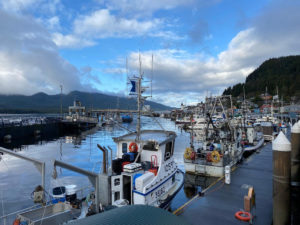
Ward’s Cove is just a few miles from Ketchikan and we bus there. Ketchikan is the fourth largest city in Alaska… after Anchorage, Fairbanks, and Juneau. It’s the totem pole capital of the world. Ketchikan has only 8,000 people and four stop lights. It boasts a Walmart and McDonalds. You can feel the infusion of cash from cruise ship tourists to the Ketchikan economy. I know we dropped $100!
We take photos of fishing boats and walk to Creek Street, a charming street once Ketchikan’s red light district. Otters play in the creek. Certainly looks like you could buy a house here for not much money. The airport is across the water way. Apparently you ferry to the terminal. There’s lots of seaplane activity. We meet “the sisters” who are following their tradition and traveling together as they like to do. Paula and Erica, on the loose, leaving their loved ones at home back East. We share hearty laughs and talk about how wonderfully disconnected we are from the news, from CNN.
Alaska and Oil

Thankfully, we’d never see oil facilities on our cruise, other than tankers plying the waters, likely running Alaskan oil from Valdez to refineries in Washington and California.
But we know that oil is a big deal in Alaska. It’s part of the story indeed. Oil and gas are the State’s largest industry, the largest component of Alaska’s economy. That said, Alaska is #6 in oil production by state – following Texas, North Dakota, New Mexico, Oklahoma, and Colorado. It’s all relative: Fully 85% of Alaska’s State budget is supplied by oil revenues.
The Trans-Alaska Pipeline System (TAPS) just turned 45 years old. The 48-inch, 800.3-mile pipe transports 3.86% of the nation’s oil, bracing temperatures that range from -80 to 95 degrees F. During its construction, care was taken not to disrupt the permafrost, and to allow for wildlife passage. Spanning Alaska, TAPS includes the pipeline itself, 11 pump stations, several hundred miles of feeder lines, and the Valdez Marine Terminal. It was in August of 1977 that the first vessel sailed out of the Valdez Marine Terminal, full of Alaska North Slope crude blends.
There have been oil leaks along the pipeline, and then of course, the massive oil spill in 1989. Then, the Exxon Valdez supertanker hit Prince William Sound’s Bligh Reef, releasing over 10 million gallons of oil, impacting 1,300 miles of shoreline.
TAPS reached peak flow in 1988, and since then has declined as oil exploration and development declined. For years, the oil industry claimed that the pipeline system was less efficient with less oil, so the industry it pushed for more oil production only to be met with opposition.
Currently Alaskan oil producers extract ~159 million barrels a year. At times it was delivering considerably more, 1.5 million barrels a day, nearly 25% of U.S. oil production. Between 1990 and 2020 oil production in Alaska was cut in half. Why? Oil development is expensive and controversial in Alaska. Furthermore, fossil-fuel investors have been shifting their focus to what they perceive to be more profitable alternatives, especially shale and tight-oil basins in the Lower 48.
Reflections
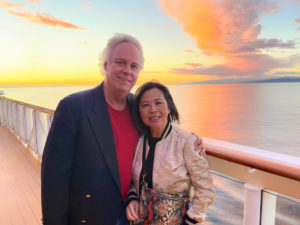
The last day and night, we head south… the long road home. This time, the clouds have lifted, a dark shroud has been relieved. We’re now able to see the wild British Columbia coastline. There’s a spirit of comradery on the ship. We pass freighters and tankers and fishing vessels.
Gads, what an adventure. Far from backpacking and sailing Zephyr with Rob in Maine… this was a totally different experience. We’d seen so much. Almost every night, we watched a show – Kinky Boots, the Choir of Man, the Beatles Invasion — the latter of which had us all singing together at the top of our lungs. Midpoint, I forgot what day of the week it was.
The ship turns to port as we round the southern tip of Vancouver Island. The sun is setting with bursts of light created by rain showers in the distance. We dock in Victoria quite late in the evening and just for a few hours. Terry and I stay on board and reminisce about our travels there some years ago, starting off in the Olympic National Park, then in Victoria renting a small motor boat for the two of us to fully experience the vast Straits of Juan de Fuca.
Back to Sea-Tac, Alaska Airlines to Bob Hope, Uber home… There’s only one thing better than getting away, and that’s getting home. We pick up the pooch; the cats are most happy to see us. Time to unpack, do laundry, and check out photos.
Certainly, our get-away adventure took us inside some of Alaska’s great nature. The panhandle has whetted our Alaskan appetite. We saw big mountains, big glaciers, and big weather. The rain and dark skies were in sober contrast to the brilliance we’d had in Seattle and that we’re used to here in Los Angeles. There is so much water and wildlife; so much majestic beauty. We also appreciate that many Alaskans are living the harsh realities of living on America’s last frontier. We are primed now, to come back and to explore Alaska more… in summer! I want to go to Denali National Park, to visit my cousin in Homer, and perhaps raft some of Alaska’s wild rivers.
Our memories are certainly painted with locations, and more so, colored by people. The ship’s wonderful staff, our steward, fellow passengers on elevators, in hot tubs, at the bar. So many random encounters; just plain fun. We met a woman who used to be in our Tai Chi school, a spine surgeon from New Hampshire, Tony and his gal from Hawaii, my bud Carlos from Florida. We really enjoyed sharing some of their honeymoon time with our new buds Zach and Luci! We joke around with Rose-Lee from the Bahamas at the Johns Hopkins Glacier. Her life and bragging rights would be complete if she could see a whale. We sent her our video that she said might work well… just the proof she needs!
Flanigan’s Ego-Logic Podcast Updates
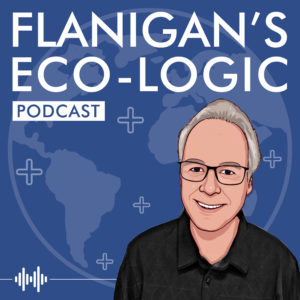
Lots to report on the podcast front. I’ve had great conversations this past month! You can use the links below to check out our recent podcasts. And you can always go to Spotify and type in “Ted Flanigan” or just “Flanigan” to access our library of 100+ podcasts.
Recently Released:
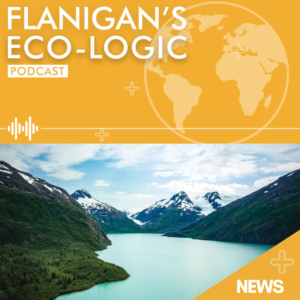
This issue of EcoNet News, Volume 24, Issue #10 is also available in podcast format. It’s a travelogue special on Ted’s recent trip to the Panhandle of Alaska.

- Flanigan’s Eco-Logic Podcast: Jigar Shah on Using Federal Funds to Advance Clean Energy Technologies
In this episode of Flanigan’s Eco-Logic, Ted speaks with Jigar Shah, Director of the Loan Programs Office at the U.S. Department of Energy.
Jigar discusses how the Loan Programs Office operates in terms of lending and taking risks to achieve its goals. He gives the example of how it helped Tesla scale up, and how they are now working to support the conversion of the Intermountain Power Plant from coal to hydrogen.
Jigar demonstrates the incredibly broad reach of the Loan Programs Office, especially now that they have significantly more funding since the passage of the Inflation Reduction Act. He also shares the fulfillment of working in the nation’s capital at this time in history, when energy security has become a national priority. It is time to scale up to become energy independent, and to drive down energy costs and carbon in the process.

In this episode of Flanigan’s Eco-Logic, Ted speaks with Rick Heede, Director of the Climate Accountability Institute.
Rick discusses his early roots in Norway, his move to the United States, and his studies in energy and climate change that brought him to Colorado. He describes his early works studying carbon concentrations at the National Center for Atmospheric Research in Boulder, CO, and later joining the Rocky Mountain Institute as one of the first staff members. He and Ted reminisce on the early days and the creativity of founder, Amory Lovins.
Rick goes on to share his experiences in quantifying carbon emissions, conducting greenhouse gas inventories, and calculating Scope 3 aviation emissions. He then dives into his work at the Carbon Accountability Institute, describing “The Carbon Majors” study, which details countries and companies that have the largest carbon footprint on a global scale. Rick demonstrates his passion for detailed quantification, ensuring that all aspects of the energy chain are accounted for, and that accountability is taken by those companies that knowingly contributed to the dire consequences of climate change.

In this episode of Flanigan’s Eco-Logic, Ted speaks with Chris Lane, Chief Executive Officer at the Aspen Center for Environmental Studies.
Chris discusses his awakening to nature and early fascination with birds, his upbringing in the southern United States, and his studies in environmental engineering at University of Florida, touching on his collegiate boxing prowess, and ultimately his move west to Colorado. He describes his early works with Ted at IRT Environment conducting case studies on exemplary energy efficiency programs.
Chris goes on to share his experience as the first Environment Affairs Director at Aspen Skiing Company, building a LEED certified building — The SunDeck — at the top of Aspen Mountain. He also talks about his work at Xanterra, where he directed the resort management firm’s sustainability program, and was instrumental in building a 2 MW solar field in Death Valley.
He then dives into his work at the Aspen Center for Environmental Studies (ACES), leading a staff of 45 employees who work with partner organizations, schools, government agencies, and other key decision makers to tackle regional environmental issues around ecological literacy, forest health, regenerative agriculture, land restoration, and climate change to advance conservation and education outcomes and create life-long commitments to the Earth.
